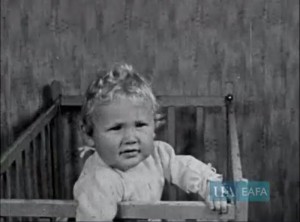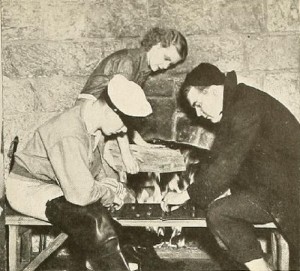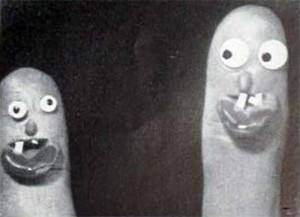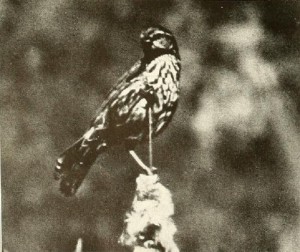
"To make a family film of youngsters that is entertaining to a stranger is quite an achievement, but to make a family picture that is, at the same time, an almost perfect record of the really human qualities of children and parents is a truly notable accomplishment. This is what John Martin has done in his picture, A Day with the Young Martins. His theme is the "from dawn to dusk" story of the Martin family, and he wisely has avoided emphasizing the clock or other obvious methods of holding the picture together. Instead, the story seems to tell itself, and the little episodes that must have been planned, or they could not have been caught with the aid of lighting equipment and camera, have a natural, sincere quality that is very welcome. The picture rates chiefly because of its delightful treatment, but technically it is entirely adequate." Movie Makers, Dec. 1936, 542.
"Frances Christeson and Harry Merrick have shown in their film, Architecture and Fine Arts, what can be done with the motion picture camera by sensitive, yet systematic, movie makers. Produced under the supervision of A. C. Weatherland, dean of the College of Architecture and Fine Arts at the University of Southern California, the picture shows students at work and gives glimpses of class room technique in teaching most of the fine arts. Although no section of the film is long or detailed enough to serve the purpose of teaching, the film, as a whole, gives a very clear and concise picture of the scope of the work of the architecture and fine arts college of the University of Southern California. Technically and cinematically, this record is superb; beautiful compositions, carefully selected and composed scenes, combined with titles of distinction, make it a truly outstanding production. Included in the picture, that is for the most part in black and white, are color sequences of stained glass windows." Movie Makers, Dec. 1936, 542.

"East Coast, produced by the Rockville Cinema Club, is a picture that keeps the most jaded critic interested in its outcome. Carefully staged and convincingly acted, this story of the eternal triangle has an original twist. The production shows painstaking attention to story detail and photography, that leaves with the audience the feeling of having seen a finished picture. The acting was far above the average and shows the result of the club's previous experiences in making this type of picture. The sets were largely laid out of doors, but, both indoors and out, the exposure and lighting were handled in a most finished and competent manner. Smooth and logical, the scenarization, editing and titling represent a vast amount of careful preparation." Movie Makers, Dec. 1936, 542.
"Moroccan Cities, by Gwladys Sills, stands out among amateur travel studies for its very real achievement of that intangible something — glamor. The mystery of shrouded Arabs, the glare of white buildings in the sunlight and the fascinating pulsation of life in the native markets, all these have been captured with marked success in this one reel record. To accomplish this, Mrs. Sills has brought into play a fine feeling for human interest and a genuine flair for the dramatic in photographic, treatment. Her material has been critically edited and sensitively titled, with that selectivity which is an artistic necessity in all real creative work." Movie Makers, Dec. 1936, 542.

"A perfectly delightful holiday in personal filming, replete with humor, and imagination, is the comedy, Nite Life, produced by J. Kinney Moore, entirely in Kodachrome and, what is more, almost entirely in interior Kodachrome, by artificial light. Mr. Moore, in his work, refutes the contention, sometimes heard, that the amateur should be wary of film comedy. And, beside negotiating this pinnacle successfully, the producer has added an outstanding technical handling of Kodachrome, as well as a highly diverting and intelligent use of the various camera illusions it is possible to produce with the aid of modern 16mm. equipment. The obvious zest and pleasure with which the actor producer entered into the creation of this film add immeasurably to its value as a genuine document of personal filming achievement. Examples of carefully planned and executed trick photography follow one another in such rapid succession in the film that the spectator is left time only to gasp. However, these tricks are not executed simply for their own sake, but strictly in accordance with the furtherance of the plot. It must be said that, in the second part of the film, the author does yield slightly to the temptation of attenuating the action somewhat in order to spin out his bag of tricks. But the film as a whole is so delightful that any audience could easily forgive this small shortcoming." Movie Makers, Dec. 1936, 542.

"On Every Hand, filmed by William L. Zeller, is one of those pictures, not infrequently found in the Ten Best selections, that make one marvel at the producer's infinite patience and deep knowledge of a special field. This is a study of those birds that can be found on every hand in the countryside and in the fields of America but which the average man fails to recognize, or even see, much less lovingly study as does Mr. Zeller. In this finished picture, there are many closeups made in the open of birds and their nests, which represent such a colorful variety of bird life as to give one something of a feeling of awe for the patience that Mr. Zeller must have exercised to catch the scenes. The picture is all in color, which brings a revelation of its own, and the continuity and titles are contrived to make an essentially record picture into good entertainment. For this quality, credit goes chiefly to the extremely well written titles and the editing." Movie Makers, Dec. 1936, 542.
"In Two Weeks, W. W. Champion has contrived that rare and refreshing thing — a personal record picture implicit with general human interest. Telling the story of a fortnight's pack trip with friends through Yosemite, the film gets off to a flying start with a delightfully detailed sequence of camp preparations. With complete naturalness, we are made acquainted with each of the vacation party. When, in good time, they set off down the trail, we feel quite sure that these people will prove of more interest than the locales that they will visit. Mr. Champion does not disappoint us, as he continues with an adroitly spun pattern of personalities and places. Crisp, steady and effectively angled, the photography of the film, in both monochrome and color, is of able assistance to the imaginative treatment." Movie Makers, Dec. 1936, 542.
"As We Forgive, produced by the Religious Motion Picture Foundation and filmed by Kenneth F. Space, with the technical assistance of Dan Lindsay, is a fine example of weaving the theme of the picture into the very warp and woof of its photographic material. The makers of this photoplay had a sincere and simple theme to present, and the excellence of their presentation lay in the fact that every detail of the handling, both in technique and continuity, was done sincerely and simply. It is this carefully worked out unity of treatment with theme that enables the film to serve as a model for producers of photoplays with a message. The filmers particularly are to be congratulated on their handling of child actors, one of the most difficult problems to be solved successfully in any field of the drama. From the technical point of view, we may remark the well exposed interiors, in which the lighting was carefully planned to give the effect of normal illumination; the fine photographic quality displayed in the closeups and camera angles and the smooth unity of the entire technical handling." Movie Makers, Dec. 1936, 542.
"In Mount Vernon Seminary, the T. W. Willard Motion Picture Company has made a remarkable Kodachrome publicity picture. No interior was too large for their color work, as is clearly shown by the fine shots of a "prom." Large rooms with groups of girls taken by artificial light were rendered in true colors with striking effect. The film demonstrates quite clearly how successfully color can be used in industrial and publicity filming and that no special limitations are involved. The most attractive titles were double exposed on well chosen bits of school scenery. The film has an air of friendliness and polish that is entirely in keeping with the spirit of the school it portrays. Just enough of the right things are shown to make a favorable impression on prospective patrons of the school." Movie Makers, Dec. 1936, 548.
"An outstanding example of what may be done with ordinary 16mm. equipment in the factory is to be found in The Story of Maytag, a black and white industrial film made by Fred Maytag, II. The problems of picturing the manufacture of washing machines in complete detail involved some tremendous lighting difficulties. Mr. Maytag handled these with ease, and throughout the film there is the conviction that the clear, clean photography scarcely could be improved. While the film was designed for use within the sales organization, the procedure of manufacture is so clearly pictured that it is not only comprehensible to the layman but interesting as well." Movie Makers, Dec. 1936, 548-549.
Total Pages: 299